31.08.2025
James Webb Space Telescope spots odd planet-forming disk around infant star
'This challenges current models of disk chemistry and evolution'
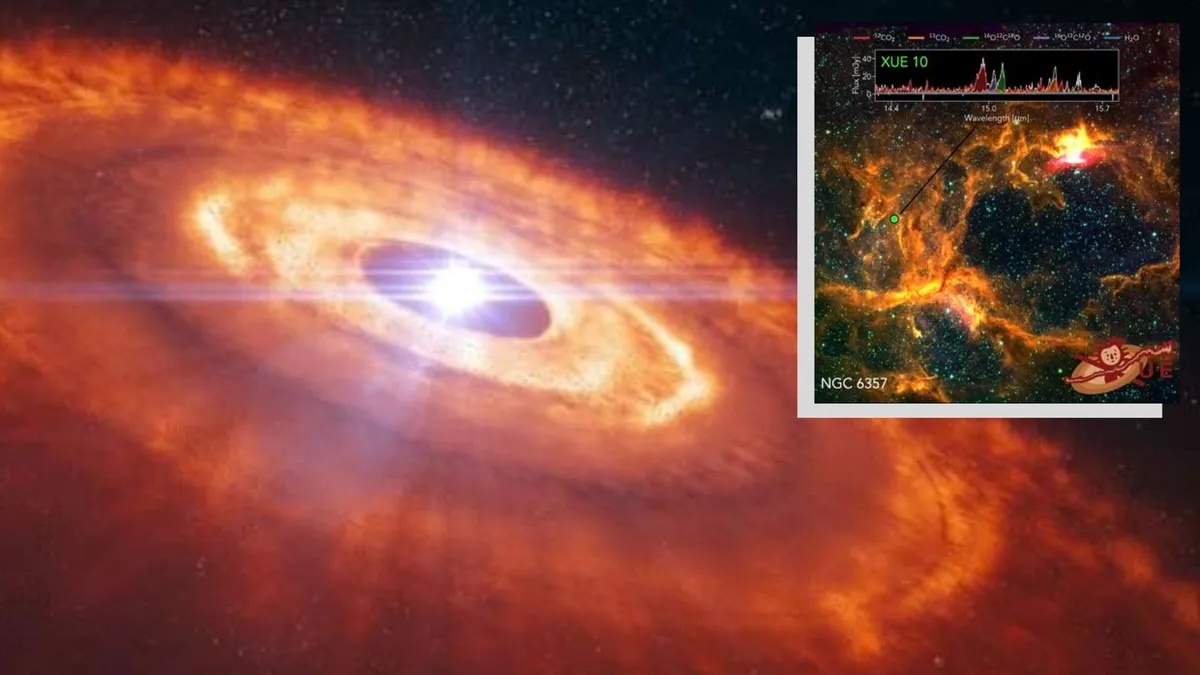
Main: An illustration of a protoplanetary disk around an infant star. Inset: image of the star-forming region NGC 6357 with the young star XUE 10 as seen by the JWST. (Image credit: (Main) ESO/L. Calçada (Inset) Stockholm University (SU) and María Claudia Ramírez-Tannus, Max Planck Institute for Astronomy (MPIA).)
Using the James Webb Space Telescope (JWST), astronomers have discovered a strange disk of gas and dust around an infant star that could challenge current models of planet formation.
The protoplanetary disk has an odd chemical composition. It features a surprisingly high concentration of carbon dioxide in the region in which rocky planets like Earth are expected to form and is also unexpectedly low in water content.
The protoplanetary disk investigated by JWST surrounds the infant star XUE 10, which is located around 5,550 light-years from Earth in the vast star-forming region known as NGC 6357. The new discovery was made by the eXtreme Ultraviolet Environments (XUE) collaboration, a research team that focuses on how intense fields of radiation impact the chemistry of protoplanetary disks.
"Unlike most nearby planet-forming disks, where water vapor dominates the inner regions, this disk is surprisingly rich in carbon dioxide," XUE collaboration team member Jenny Frediani, of Stockholm University in Sweden, said in a statement.
"In fact, water is so scarce in this system that it’s barely detectable — a dramatic contrast to what we typically observe," Frediani added. "This challenges current models of disk chemistry and evolution, since the high carbon dioxide levels relative to water cannot be easily explained by standard disk evolution processes."
Strange chemistry
Stars form when overdense patches clump together in vast clouds of gas and dust, eventually gathering enough mass to undergo gravitational collapse. What remains of the material that birthed this still-growing protostar swirls around it, flattening out and eventually forming a protoplanetary disk in which planets can be born.
Scientists currently theorize that planet formation occurs when "pebbles" rich in water ice drift from the colder outer regions of a protoplanetary disk to its warmer inner regions. These higher temperatures cause solid ice to transform directly into gas, a process known as sublimation.
This usually also results in telescopes like JWST spotting strong signals from water vapor in protoplanetary disks. The disk around XUE 10, however, showed strong carbon dioxide signals.
"Such a high abundance of carbon dioxide in the planet-forming zone is unexpected," said XUE Collaboration member and Stockholm University researcher Arjan Bik. "It points to the possibility that intense ultraviolet radiation— either from the host star or neighboring massive stars — is reshaping the chemistry of the disk."
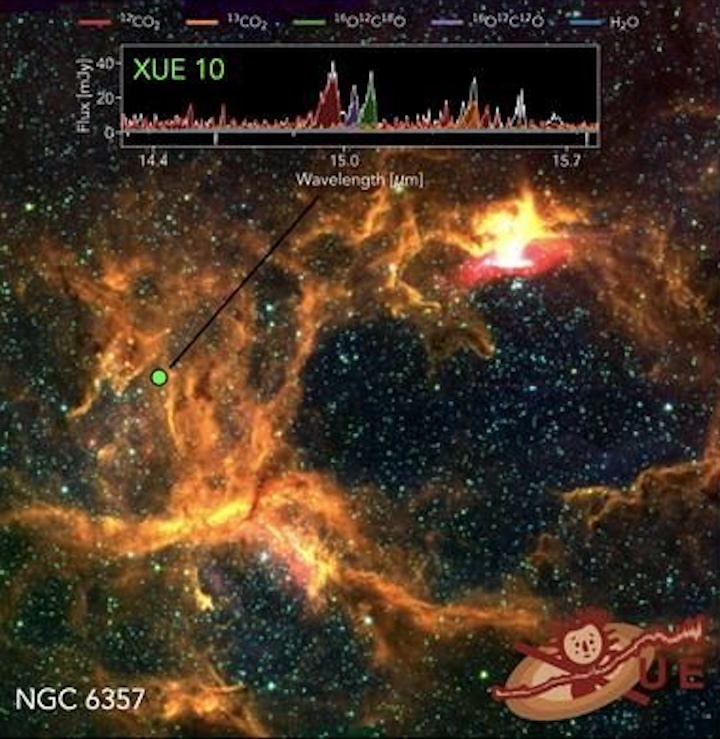
The star-forming region NGC 6357, with the position of the young star XUE 10 indicated (Image credit: Stockholm University (SU) and María Claudia Ramírez-Tannus, Max Planck Institute for Astronomy (MPIA).)
This wasn't the only surprise that JWST delivered to the team with regard to XUE 10 and its protoplanetary disk. Data from the disk revealed molecules of carbon dioxide, enriched with the carbon isotopes carbon-13 and the oxygen isotopes oxygen-17 and oxygen-18.
The presence of these isotopes could help explain why certain unusual isotopes are left in fragments of the early solar system in the formation of meteorites andcomets.
The research demonstrates JWST's impressive ability to detect chemical fingerprints in distant protoplanetary disks during crucial eras of planet formation.
"It reveals how extreme radiation environments — common in massive star-forming regions — can alter thebuilding blocks of planets," said team leader Maria-Claudia Ramirez-Tannus from the Max Planck Institute for Astronomy in Germany. "Since most stars and likely most planets form in such regions, understanding these effects is essential for grasping the diversity of planetary atmospheres and their habitability potential."
The team's research was published on Friday (Aug. 29) in the journal Astronomy & Astrophysics.
Quelle: SC
----
Update: 10.09.2025
.
NASA Webb Looks at Earth-Sized, Habitable-Zone Exoplanet TRAPPIST-1 e
Scientists are in the midst of observing the exoplanet TRAPPIST-1 e with NASA’s James Webb Space Telescope. Careful analysis of the results so far presents several potential scenarios for what the planet’s atmosphere and surface may be like, as NASA science missions lay key groundwork to answer the question, “are we alone in the universe?”
“Webb’s infrared instruments are giving us more detail than we’ve ever had access to before, and the initial four observations we’ve been able to make of planet e are showing us what we will have to work with when the rest of the information comes in,” said Néstor Espinoza of the Space Telescope Science Institute in Baltimore, Maryland, a principal investigator on the research team. Two scientific papers detailing the team’s initial results are published in the Astrophysical Journal Letters.
Image A: Trappist-1 e (Artist's Concept)

Of the seven Earth-sized worlds orbiting the red dwarf star TRAPPIST-1, planet e is of particular interest because it orbits the star at a distance where water on the surface is theoretically possible — not too hot, not too cold — but only if the planet has an atmosphere. That’s where Webb comes in. Researchers aimed the telescope’s powerful NIRSpec (Near-Infrared Spectrograph) instrument at the system as planet e transited, or passed in front of, its star. Starlight passing through the planet’s atmosphere, if there is one, will be partially absorbed, and the corresponding dips in the light spectrum that reaches Webb will tell astronomers what chemicals are found there. With each additional transit, the atmospheric contents become clearer as more data is collected.
Primary atmosphere unlikely
Though multiple possibilities remain open for planet e because only four transits have been analyzed so far, the researchers feel confident that the planet does not still have its primary, or original, atmosphere. TRAPPIST-1 is a very active star, with frequent flares, so it is not surprising to researchers that any hydrogen-helium atmosphere with which the planet may have formed would have been stripped off by stellar radiation. However many planets, including Earth, build up a heavier secondary atmosphere after losing their primary atmosphere. It is possible that planet e was never able to do this and does not have a secondary atmosphere. Yet researchers say there is an equal chance there is an atmosphere, and the team developed novel approaches to working with Webb’s data to determine planet e’s potential atmospheres and surface environments.
World of (fewer) possibilities
The researchers say it is unlikely that the atmosphere of TRAPPIST-1 e is dominated by carbon dioxide, analogous to the thick atmosphere of Venus and the thin atmosphere of Mars. However, the researchers also are careful to note that there are no direct parallels with our solar system.
"TRAPPIST-1 is a very different star from our Sun, and so the planetary system around it is also very different, which challenges both our observational and theoretical assumptions,” said team member Nikole Lewis, an associate professor of astronomy at Cornell University.
If there is liquid water on TRAPPIST-1 e, the researchers say it would be accompanied by a greenhouse effect, in which various gases, particularly carbon dioxide, keep the atmosphere stable and the planet warm.
“A little greenhouse effect goes a long way,” said Lewis, and the measurements do not rule out adequate carbon dioxide to sustain some water on the surface. According to the team’s analysis, the water could take the form of a global ocean, or cover a smaller area of the planet where the star is at perpetual noon, surrounded by ice. This would be possible because, due to the TRAPPIST-1 planets’ sizes and close orbits to their star, it is thought that they all are tidally locked, with one side always facing the star and one side always in darkness.
Image B: TRAPPIST-1 e Transmission Spectrum (NIRSpec)

Innovative new method
Espinoza and co-principal investigator Natalie Allen of Johns Hopkins University are leading a team that is currently making 15 additional observations of planet e, with an innovative twist. The scientists are timing the observations so that Webb catches both planets b and e transiting the star one right after the other. After previous Webb observations of planet b, the planet orbiting closest to TRAPPIST-1, scientists are fairly confident it is a bare rock without an atmosphere. This means that signals detected during planet b’s transit can be attributed to the star only, and because planet e transits at nearly the same time, there will be less complication from the star’s variability. Scientists plan to compare the data from both planets, and any indications of chemicals that show up only in planet e’s spectrum can be attributed to its atmosphere.
“We are really still in the early stages of learning what kind of amazing science we can do with Webb. It’s incredible to measure the details of starlight around Earth-sized planets 40 light-years away and learn what it might be like there, if life could be possible there,” said Ana Glidden, a post-doctoral researcher at Massachusetts Institute of Technology’s Kavli Institute for Astrophysics and Space Research, who led the research on possible atmospheres for planet e. “We’re in a new age of exploration that’s very exciting to be a part of,” she said.
The four transits of TRAPPIST-1 e analyzed in the new papers published today were collected by the JWST Telescope Scientist Team’s DREAMS (Deep Reconnaissance of Exoplanet Atmospheres using Multi-instrument Spectroscopy) collaboration.
The James Webb Space Telescope is the world’s premier space science observatory. Webb is solving mysteries in our solar system, looking beyond to distant worlds around other stars, and probing the mysterious structures and origins of our universe and our place in it. Webb is an international program led by NASA with its partners, ESA (European Space Agency) and CSA (Canadian Space Agency).
Quelle: NASA
----
Update: 27.09.2025
.
James Webb Space Telescope peers deep into the heart of star formation in our Milky Way galaxy
This massive star-forming cloud is working surprisingly fast.
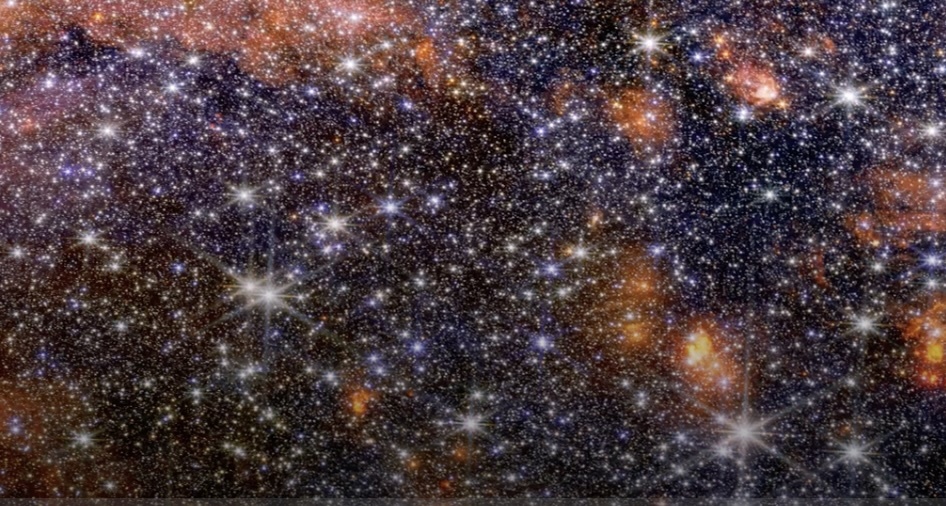
A maelstrom of star formation close to the center of our galaxy has been revealed in two different wavelengths by the James Webb Space Telescope (JWST), its beautiful images highlighting the intensity of star-birth in the region and deepening the mystery of why star formation at the very heart of our galaxy is so sluggish.
Sagittarius B2 is a dense cloud of molecular gas located about 390 light-years from the black hole Sagittarius A* at the center of our Milky Way galaxy. At about 150 light-years across and containing enough gas to assemble 3 million sun-like stars, B2 is the largest, most massive and most active star-forming region in our entire galaxy.
Yet, B2 is at odds with the rest of the galactic center. As massive as B2 is, it contains only 10% of the molecular gas in the galactic center, gas that forms the building blocks of stars. Still, despite only having a modest fraction of gas relative to the galactic center as a whole, B2 produces half of all the stars there. It is an enduring mystery why B2 has such intense star formation while the rest of the galactic center has proportionately lower rates of star-birth.
That's why the new observations by the JWST are so important in understanding what drives and what puts the brakes on star formation in the galactic center.
"Webb's powerful infrared instruments provide detail we've never been able to see before, which will help us to understand some of the still-elusive mysteries of massive star formation and why Sagittarius B2 is so much more active than the rest of the galactic center," said study co-author Adam Ginsburg of the University of Florida in a statement.
One theory is that powerful, complex magnetic fields that are entwined around the galactic center and its retinue of molecular clouds similar to B2 could play a deciding factor, but the hows and whys there are still to be determined.
For its part, JWST can get to the heart of the star formation in B2 thanks to the space telescope's powerful infrared vision that can peer through much of the obscuring dust in the cloud. Presented here are two images, one taken at shorter infrared wavelengths by the JWST's Near Infrared Camera (NIRCam) and the other captured at longer wavelengths by the telescope's Mid-Infrared Instrument (MIRI).
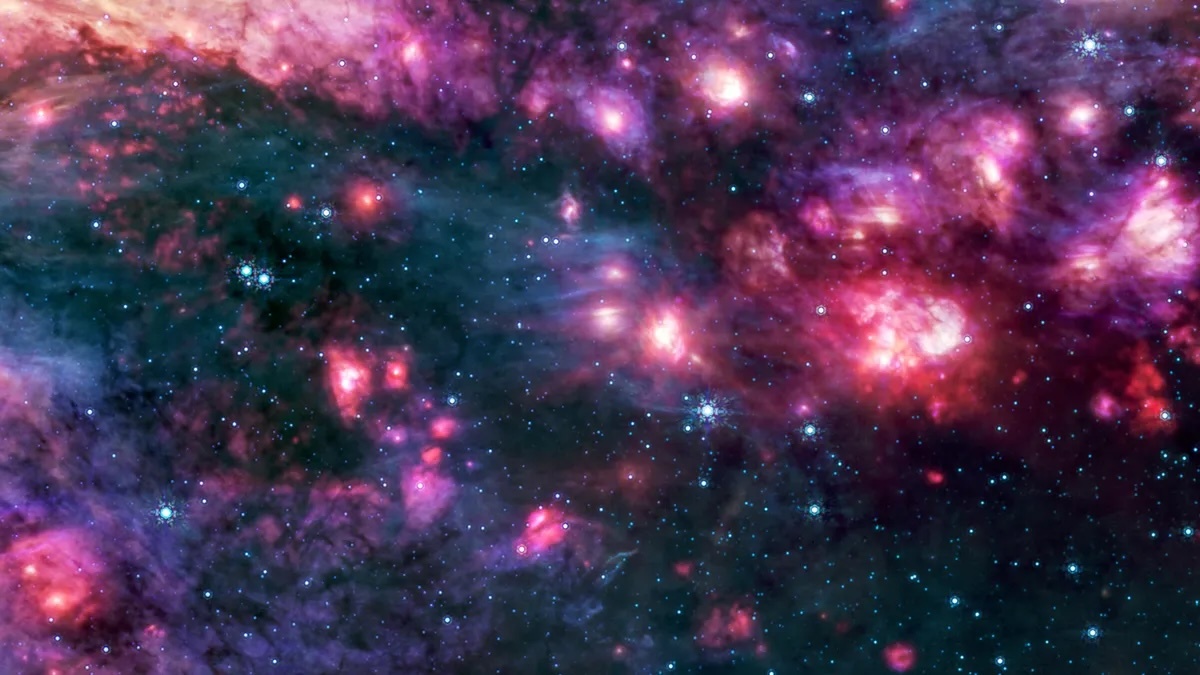
JWST's mid-infrared view of Sagittarius B2, showing more extensive, dusty nebulosity being illuminated by newly born stars. (Image credit: NASA/ESA/CSA/STScI/Adam Ginsburg (University of Florida)/Nazar Budaiev (University of Florida)/Taehwa Yoo (University of Florida)/Image Processing: Alyssa Pagan (STScI).)
In the NIRCam image, we see myriad stars in B2 amid hazy patches of nebulosity. In the darkest areas where we can't see nebulosity there is cosmic dust too dense even for NIRCam to see through.
So, we turn to MIRI's image, which is able to penetrate the thicker dust in B2. Here, all but the brightest stars have faded to invisibility since they do not radiate much at these long infrared wavelengths. Meanwhile, the nebulosity across the entire scene has blossomed into life, revealing the true scale of star-birth in the region as each of those bright clouds is being illuminated by the light of very young but massive stars that are still in the process of growing.
The aim of the JWST observations is to better understand the history of star formation in B2. Has it been ongoing for many millions of years and many generations of stars, or has it only recently ignited? The answer will help place B2 into context with the rest of the galactic center as astronomers search for clues as to what stifles star-birth at the heart of our galaxy.
The findings could have broader repercussions. The intensity of star formation in B2 is believed by astronomers to be similar to conditions in the early universe when the first stars were formed in a flurry of frenzied activity. By learning what governs star formation in the galactic center, we could also be learning about what governed star formation in the aftermath of the Big Bang.
A study about these results can be viewed on the paper repository arxiv.
Quelle: SC
----
Update: 2.10.2025
.
JWST delivers 1st weather report of nearby world with no sun — stormy and covered with auroras
"Understanding these weather processes will be crucial as we continue to discover and characterize exoworlds in the future."
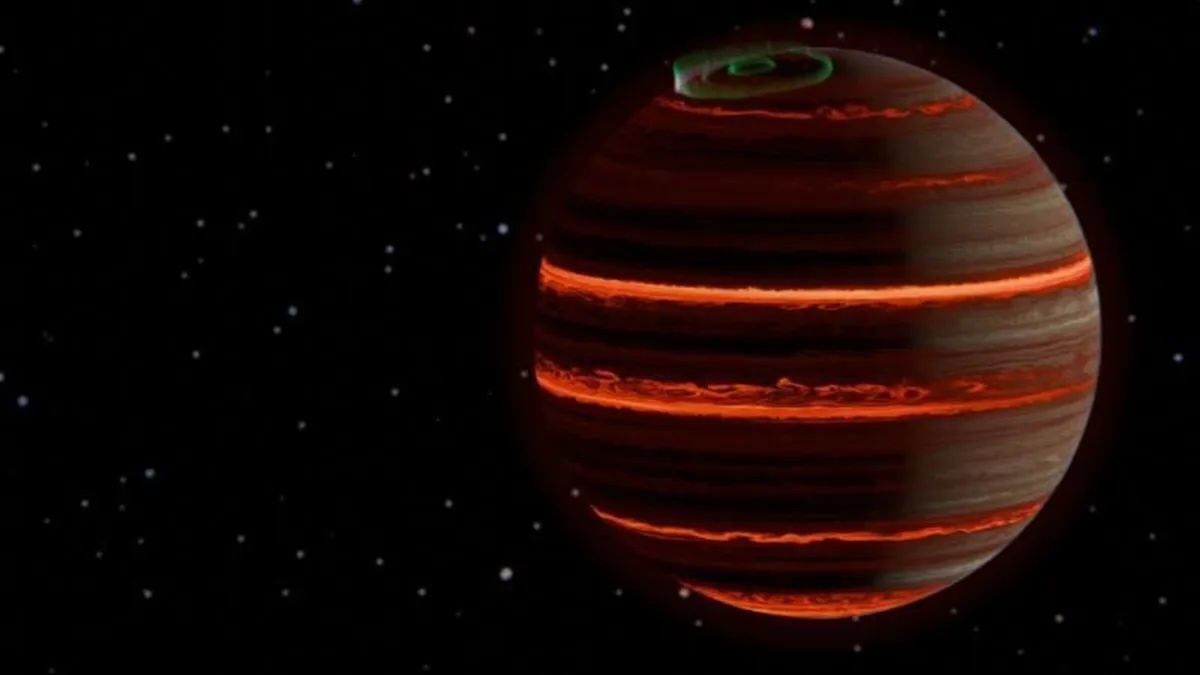
Auroras on the rogue world SIMP-0136 are heating its upper atmosphere, according to new James Webb Space Telescope observations. (Image credit: Evert Nasedkin/Trinity College Dublin)
The latest weather forecast doesn't come from Dublin, London or New York — it comes from deep space, where a lonely world drifts without a sun and glows with auroras more dazzling than Earth's northern lights.
The world, called SIMP-0136, is about 200 million years old and lies about 20 light-years away in the constellation Pisces. It isn't quite a world nor a star. Astronomers classify it as a brown dwarf, sometimes dubbed "failed stars." Like stars, this world forms from collapsing clouds of gas, but it never grows massive enough to sustain hydrogen fusion in its core — the defining trait of a star.
And unlike Earth, SIMP-0136 doesn't orbit its own sun. It's a rogue world that spins once every two and a half hours as it floats freely through space. Now, thanks to the James Webb Space Telescope (JWST), astronomers have delivered the most detailed "weather report" yet for this strange world, tracking subtle changes in its atmosphere over a full rotation.
The study, published Sept. 26 in the journal Astronomy & Astrophysics, is the first to track how a brown dwarf's atmosphere changes as it spins, revealing shifts in temperature, chemistry and clouds. Astronomers say the findings open a new window onto the weather of worlds beyond our solar system.
"These are some of the most precise measurements of the atmosphere of any extra-solar object to date, and the first time that changes in the atmospheric properties have been directly measured," study lead author Evert Nasedkin of the Trinity College Dublin in Ireland said in a statement.
"Understanding these weather processes will be crucial as we continue to discover and characterise exoworlds in the future," study co-author Johanna Vos of Trinity College Dublin said in the same statement.
The JWST's sensitive instruments captured minute changes in brightness as SIMP-0136 spun, letting scientists map its atmospheric layers. Astronomers had long suspected the flickering light came from patchy clouds. Instead, the study found that SIMP-0136's clouds, made of sand-like grains of hot silicates, are remarkably stable.
The real drama was instead unfolding higher up in the atmosphere, where the team discovered a layer of air nearly 570 degrees Fahrenheit (300 degrees Celsius) warmer than models predicted. According to the study, the extra warmth is most likely caused by auroras.
On Earth, auroras appear as shimmering curtains of light when charged particles from the solar wind interact with our world's magnetic field. On SIMP-0136, however, a much stronger magnetic field supercharges this effect, with charged particles slamming into the atmosphere so forcefully that they not only glow but also pump energy into the air itself, heating the world's upper layers.
JWST also detected tiny temperature swings of less than 40 degrees Fahrenheit (5 degrees Celsius) in deeper layers, the study notes. Those tiny temperature changes might be caused by huge storm systems, possibly like Jupiter's Great Red Spot, moving across the surface as the world spins, scientists say.
Because brown dwarfs like SIMP-0136 aren't swamped by the glare of a parent star, they serve as ideal stand-ins for giant exoworlds that orbit distant suns. By studying their weather in such detail, astronomers are beginning to piece together how atmospheres behave on distant worlds.
With JWST and future observatories such as the Extremely Large Telescope and NASA's planned Habitable Worlds Observatory, astronomers hope to use the same techniques on worlds orbiting distant stars and uncover how their weather shifts and evolves over time.
A study about these results was published on Sept. 26 in the journal Astronomy and Astrophysics.
Quelle: SC
----
Update: 10.10.2025
.
Webb Telescope unveils doomed star hidden in dust
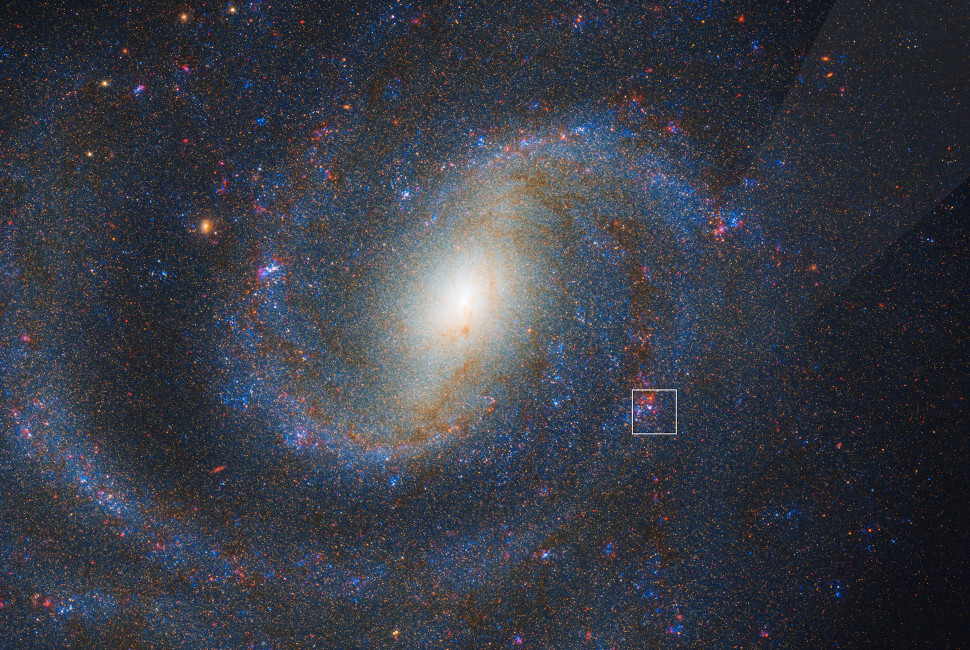
A Northwestern University-led team of astronomers has captured the most detailed glimpse yet of a doomed star before it exploded.
Using NASA’s James Webb Space Telescope (JWST), the international team identified a supernova’s source star, or progenitor, at mid-infrared wavelengths for the first time. These observations — combined with archival images from the Hubble Space Telescope — revealed the explosion came from a massive red supergiant star, cloaked in an unexpected shroud of dust.
The discovery may help solve the decades-old mystery of why massive red supergiants rarely explode. Afterall, theoretical models predict red supergiants should make up the majority of core-collapse supernovae. The new study shows these stars do explode but are simply hidden out of sight, within thick clouds of dust. With JWST’s new capabilities, astronomers can finally pierce through the dust to spot these phenomena, closing the gap between theory and observation.
The study was published in The Astrophysical Journal Letters. It marks the JWST’s first detection of a supernova progenitor.
“For multiple decades, we have been trying to determine exactly what the explosions of red supergiant stars look like,” said Northwestern’s Charlie Kilpatrick, who led the study. “Only now, with JWST, do we finally have the quality of data and infrared observations that allow us to say precisely the exact type of red supergiant that exploded and what its immediate environment looked like. We’ve been waiting for this to happen — for a supernova to explode in a galaxy that JWST had already observed. We combined Hubble and JWST data sets to completely characterize this star for the first time.”
An expert on the lives and deaths of massive stars, Kilpatrick is a research assistant professor at Northwestern’s Center for Interdisciplinary Exploration and Research in Astrophysics. Aswin Suresh, a graduate student in physics and astronomy at Northwestern’s Weinberg College of Arts and Sciences and member of Kilpatrick’s research group, is a key coauthor on the paper.
Reddest, dustiest progenitor ever observed
Using the All-Sky Automated Survey of Supernovae, astronomers first detected the supernova, dubbed SN2025pht, on June 29, 2025. Its light had traveled from a nearby galaxy called NGC 1637, located 40 million light-years away from Earth.
By comparing Hubble and JWST images of NGC 1637 from before and after the star’s explosion, Kilpatrick, Suresh and their collaborators found SN2025pht’s progenitor star. It was immediately striking — extremely bright and incredibly red. Although the star shined about 100,000 times brighter than our sun, surrounding dust obscured much of this light. The dusty veil was so thick, in fact, that the star appeared more than 100 times dimmer in visible light than it would appear without the dust. Because dust blocked out shorter, bluer wavelengths of light, the star also appeared surprisingly red.
“It’s the reddest, dustiest red supergiant that we’ve seen explode as a supernova,” Suresh said.
Massive stars in the late stages of their lives, red supergiants are among the largest stars in the universe. When their cores collapse, they explode as Type II supernovae, leaving behind either a neutron star or black hole. The most familiar example of a red supergiant is Betelguese, the bright reddish star in the shoulder of the constellation Orion.
“SN2025pht is surprising because it appeared much redder than almost any other red supergiant we’ve seen explode as a supernova,” Kilpatrick added. “That tells us that previous explosions might have been much more luminous than we thought because we didn’t have the same quality of infrared data that JWST can now provide.”
Clues hidden in dust
The deluge of dust could help explain why astronomers have struggled to find red supergiant progenitors. Most massive stars that explode as supernovae are the brightest and most luminous objects in the sky. So, theoretically, they should be easy to spot before they explode. But that hasn’t been the case.
Astronomers posit that the most massive aging stars also might be the dustiest. These thick cloaks of dust might dim the stars’ light to the point of utter undetectability. The new JWST observations support this hypothesis.
“I’ve been arguing in favor of that interpretation, but even I didn’t expect to see such an extreme example as SN2025pht,” Kilpatrick said. “It would explain why these more massive supergiants are missing because they tend to be dustier.”
In addition to the presence of dust itself, the dust’s composition was also surprising. While red supergiants tend to produce oxygen-rich, silicate dust, this star’s dust appeared rich with carbon. This suggests that powerful convection in the star’s final years may have dredged up carbon from deep inside, enriching its surface and altering the type of dust it produced.
“The infrared wavelengths of our observations overlap with an important silicate dust feature that’s characteristic of some red supergiant spectra,” Kilpatrick said. “This tells us that the wind was very rich in carbon and less rich in oxygen, which also was somewhat surprising for a red supergiant of this mass.”
A new era for exploding stars
The new study marks the first time astronomers have used JWST to directly identify a supernova progenitor star, opening the door to many more discoveries. By capturing light across the near- and mid-infrared spectrum, JWST can reveal hidden stars and provide missing pieces for how the most massive stars live and die.
The team now is searching for similar red supergiants that may explode as supernovae in the future. Observations by NASA’s upcoming Nancy Grace Roman Space Telescope may help this search. Roman will have the resolution, sensitivity and infrared wavelength coverage to see these stars and potentially witness their variability as they expel out large quantities of dust near the end of their lives.
“With the launch of JWST and upcoming Roman launch, this is an exciting time to study massive stars and supernova progenitors,” Kilpatrick said. “The quality of data and new findings we will make will exceed anything observed in the past 30 years.”
The study was supported by the National Science Foundation.
Quelle: Northwestern University
----
Update: 1.11.2025
.
James Webb Space Telescope spots the haunting Red Spider Nebula with 3-light-year-long legs
Planetary nebulas are very well dressed for Halloween.
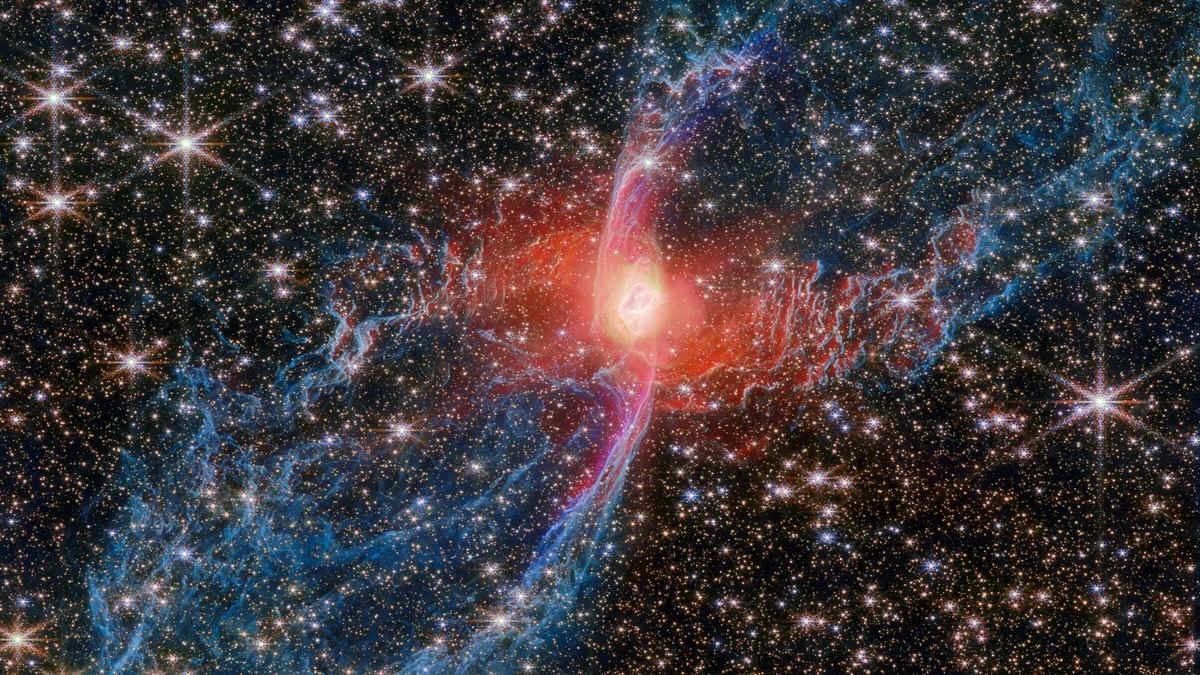
The James Webb Space Telescope's new image of the Red Spider Nebula (Image credit: ESA/Webb, NASA & CSA, J. H. Kastner (Rochester Institute of Technology))
Out in the cosmic landscape, planetary nebulas would offer the perfect Halloween doors to knock on.
They're spooky tricksters in their names, as they have nothing to do with planets at all and are rather the gory scenes of stars dying. The term "planetary nebula" actually comes from an accident. Long ago, astronomers using early-iteration telescopes thought these objects looked like planets because of how rounded they appeared. We now know this to be untrue, of course, but the planetary nebulas continue to be disguised by their own titles.
But once you've moved on from this trick, the ruse is softened by the absolute treat it is to view one of these enchanting bundles of gas and dust. Indeed, the planetary nebula seen above, known as the Red Spider Nebula and imaged by the James Webb Space Telescope (JWST), is a terrific example of the rich scientific detail and aesthetic beauty these objects can offer.
To be clear, this image isn't exactly accurate in its color, because the JWST doesn't capture images like a normal camera. Rather, it collects infrared light emitted by different parts of objects (light that's invisible to us), then sends that information back to scientists. Astronomers can put together a picture using that data, then color it artificially to make various sections stand out.
What you're looking at here is the aftermath of a sun-like star that eventually reached the end of its life and poofed out into a cool red giant star. This will happen to our sun one day as well: It will bubble out to over 200 times its regular size and destroy everything in its path, including (perhaps) Earth.
Eventually, the outer layers of such a red giant begin to shed off until the raw core of the star is revealed. As a result, you get something like what we see in the image here.
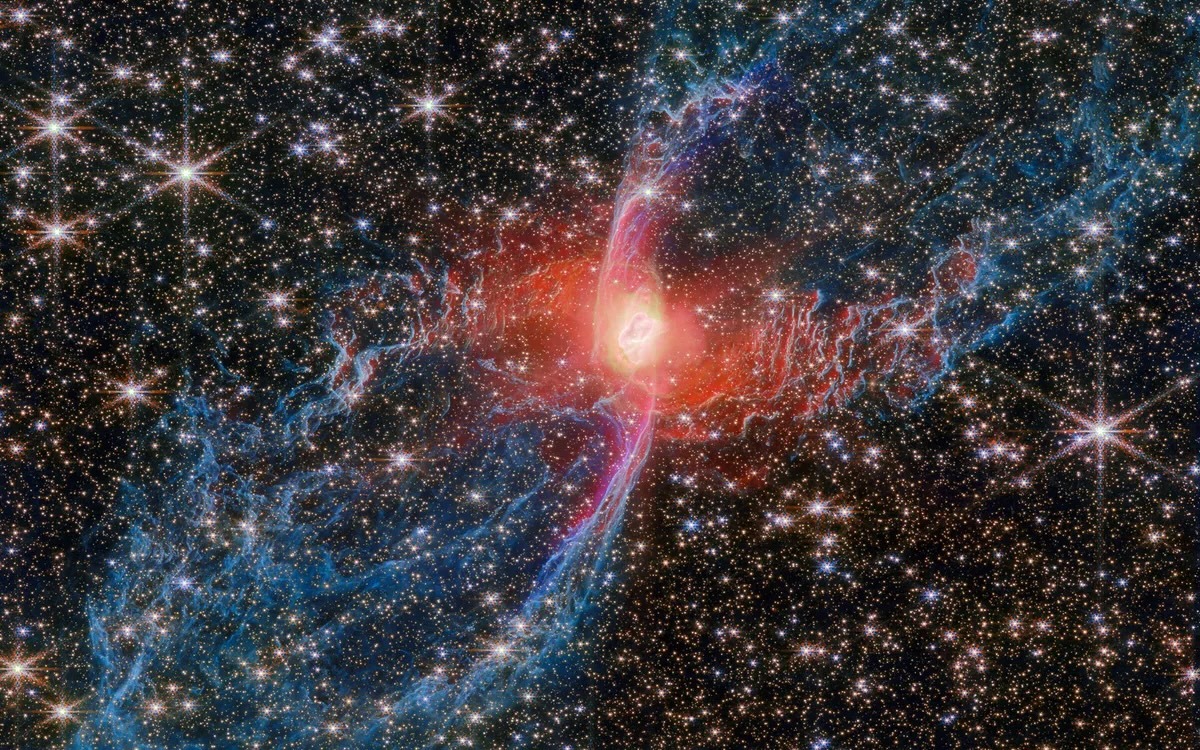
The Red Spider Nebula glows in the darkness of space. (Image credit: ESA/Webb, NASA & CSA, J. H. Kastner (Rochester Institute of Technology))
To break the Red Spider Nebula down a little bit, at the very center is a single star that you can see, but the European Space Agency explains in a statementthat there is likely also a second companion star that we just can't make out in this particular view. The reasoning there is that the specific shape of this nebula, aka its hourglass look, indicates a possible double star situation. The JWST's infrared capabilities also show a "shroud of hot dust" surrounding the visible star, ESA explains.
The lobes of the Red Spider Nebula are three light-years long each, inflated by gas from the central star shooting outward for thousands of years. The S-shape you can make out if you go from the northeast to the southwest part of the reddish area within the nebula comes from light emitted by ionized iron atoms, which refers to iron that has either gained or lost a quantity of its electrons. In fact, on that note, the blue lobes we see are representative of H2 molecules (involving two hydrogen atoms) emitting light.
Yet one of the most striking aspects of this scene comes not from the nebula itself but rather from the spectacular backdrop of stars behind it. Back when the JWST's first images were released, scientists were overjoyed to see how much detail the observatory picks up when peering into the universe, whether or not it was requested to collect that detail. That quirk of the JWST never faded, as the telescope naturally cocoons its targets in only the most deserving frames.
The twinkliest of the stars in this frame also have eight points if you look closely (two of the points are horizontal through the center and shorter than the other six), characteristic of a JWST image due to the way the telescope's hexagonal mirror works.
An iconic signature like that may make it difficult for the JWST to give us a trick like the planetary nebula crew, but at least it nails the treats.
Quelle: SC
